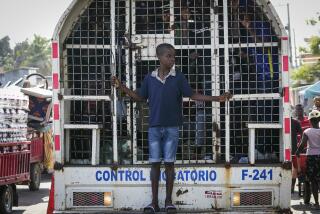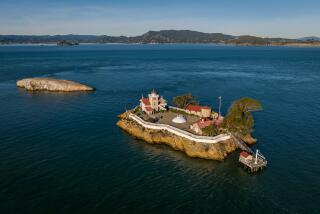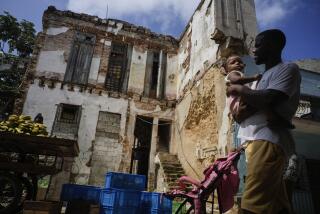Entire Neighborhoods Have Been Bulldozed for It, Residents Complain : Dominican Readies ‘Lighthouse to Columbus’
SANTO DOMINGO, Dominican Republic — Near this capital city, a gigantic, cross-shaped laser beam that will be visible for miles all over the Caribbean is being readied for the 500th anniversary of Christopher Columbus’ historic arrival in the New World.
But residents of this island nation, which the explorer first sighted in 1492, aren’t universally taken with President Joaquin Balaguer’s “Lighthouse to Columbus” and other preparations being made for the 1992 anniversary. Entire neighborhoods have been bulldozed to make way for tourist hotels and restaurants, museums and highways, giving rise to sharp protests from those affected.
One of the ironies of the anniversary preparations is the enormous amount of electricity the Columbus Lighthouse will consume--in a land that suffers from a chronic power shortage and frequent blackouts and where people in outlying areas often have to depend on candlelight.
The heavy expenditures on public works have generated large government budget deficits, and many economists blame the shortfall for last year’s 50% inflation rate. The minimum wage of about $80 a month barely covers basic necessities.
The government says that the ambitious projects are meant to spruce up the country for the expected tourist influx. Officials point out that tourism is now the country’s economic lifeline, replacing the traditional money-earner, sugar exports.
The lighthouse’s defenders say the island needs to exploit its current boom as a tourist hotspot with modern services. And Balaguer regularly appears at ceremonies to inaugurate apartments, roads, and bridges and to argue that it helps the infrastructure for development.
Nonetheless, community groups are digging in their heels to resist further demolition such as that which has left Mirador Park, an area near the lighthouse, looking like a battleground.
“Every poor person in this city is faced with the threat of displacement,” says Nicolas Guevara of the Committee to Defend Neighborhood Rights (Copadeba). “The project engineers promise them new homes,” he says. But once their old homes are demolished, residents find that the promised new homes have been given to someone else.
An official of the 500th anniversary committee, Jose Chez Checo, denies the charge. “There have been problems with some projects, but near the lighthouse area the displaced persons have been moved back into the new residences,” he says.
Extensions of major traffic arteries also are scheduled to plow through crowded barrios.
“We are convinced that this is a conscious plan to remove poor people from the city,” Guevara says. “The tourist industry wants them out for aesthetic reasons, and the government wants to remove centers of protest.”
Some of the affected zones were, in fact, hotbeds of activism in 1984 when more than 100 people died in rioting over price increases of basic necessities.
Affected residents say the officials’ main aim is to pressure people to leave.
“They asked me if I wanted money or a shack,” relates Salvador Rincon, who refused a cash payment of $700 for his demolished house. He now lives with his family of five in a precarious hut next to an open sewer while awaiting a promised apartment.
“How could I take a couple of pesos and end up in the street?” he asks.
The Copadeba group has managed to modify some demolition and change government procedures in others. Ismaela Jimenez de Blanco fought the authorities for a written promise of new housing before giving up her home: “They wanted me to just accept their verbal promises, but I said they could knock down the house on top of me first.”
Many Dominicans say that corrupt officials accept bribes to locate families in the new homes. The Roman Catholic archbishop of Santo Domingo, Nicolas de Jesus Lopez Rodrigues, confirmed that the country’s bureaucratic practices are dubious. Dominican justice, he said in a February speech, is “in the hands of drug dealers and thieves.”
In addition, critics say, the government is building too much, too fast.
“They have put too much money into circulation,” says former President Juan Bosch, a candidate to replace Balaguer in next year’s election. “This county needs industrialization, not more dependence on foreign tourists.” (The army ousted Bosch in 1963. When civil war broke out two years later, U.S. military forces intervened to impose a truce while Balaguer was put in office.)
The government scoffs at criticism of its plans, particularly for the lighthouse.
“Every great project of human imagination has had its naysayers,” declares Technical Secretary Guillermo Caram, ticking off “the Panama Canal, the Eiffel Tower, the Palace of Versailles.” “But Versailles, for example, was later the site of great triumphs of mankind--the French Revolution, the 1918 armistice, the founding of the League of Nations,” he says. “Despite the criticism, the authors of these works left their stamp on history.”
More to Read
Sign up for Essential California
The most important California stories and recommendations in your inbox every morning.
You may occasionally receive promotional content from the Los Angeles Times.










